The Stages of Development and Implementation of a Diamond Cut Grading System
The problem
Diamond Cut Study: goals, tasks, problems
Steps to development and application of a diamond cut grading system
Stage 1. Understanding of basic phenomena. Work with parametrical cut
The Viewing Conditions
Illumination
Stage 2. Basic Light Responses. Work with real diamonds
Stage 3. Master Stones for cut grading. Testing of human observation of diamond appearance
Conclusion
The problem
There is widespread agreement that the diamond industry has a need for a widely accepted and reliable cut grading system. Continual improvement of luxury goods that compete with diamonds has led to a growth in their share of consumers dollars. An advanced, but easily communicated, grading system will give the diamond industry a much needed impetus, but not only by way of creating better consumer confidence. The industry will gain more freedom in diamond cutting and this can lead to the creation of more beautiful diamonds and better profits.
Developing such a system that is acceptable and beneficial to all parties, is a complex task involving the optics of the stone as well as human taste and physiology. The implementation of such systems will require new approaches, technology and devices, as well as good communication and throughout all sectors of the industry.
Our presentation is devoted to the explanation of one methodology of diamond cut grading. In this methodology we avoid grading cut based on proportions and similar parameters. We will base our system on the optical responses of each diamond; this approach will allow the development of a universal system that will apply to all diamond shapes, and other gemstones.
Further more, this proposed system will lead to differentiation of market segments and of consumers groups.
Cut quality influences diamond beauty and value but the complexity of grading cut results in diamonds that are more and less beautiful falling into the same cell of a pricelist. To combat this, a lot of effort today goes into branding diamonds. Producing consistently beautiful new cuts can add value to branding efforts. However labs do not currently rate round diamond beauty, let alone compare and evaluate the beauty of different fancy shapes or new cuts. The short comings of current lab evaluation methods, via parameters (proportions and angles), reduces the economic need for diamond cutters to create more beautiful cuts.
Adding to the limitations of lab grading systems is the high cost of rough for empirical testing and experimentation. Development of our approach would also result in computer aided design technology to develop new cuts.
Is it possible that diamonds will be designed that are superior to diamonds considered as excellent or ideal today?
Diamond Cut Study: goals, tasks, problems
Evaluation task. Cut quality influences diamond beauty and value but the complexity of grading cut means more and less beautiful diamonds fall into one cell of pricelist.
Retail technology. Branding technology is used to gain a customer's trust concerning a given diamonds quality and beauty. Consistently beautiful new cuts will add value to such brands.
Fancy cut problem. The market can not evaluate and compare different fancy shapes.
Market for certified diamonds. The data on a certificate does not allow the evaluation of cut quality.
Grading system problem. Diamond beauty is currently evaluated via parameters (proportions and angles).
Problem of manufacturing. Diamond cutters can make better quality and create more beautiful cuts but their efforts are blocked by currently used grading systems.
Cut evolution problem. Cutters are restricted in empirical testing and develop more beautiful diamonds because of high cost of rough and because of limitations of the labs grading systems.
Lab problem in cut grading. Cut grading scales developed and used by labs result in diamonds being cut to proportions that they grade as excellent or ideal. What if progress in technology results in these diamonds no longer being considered as excellent or ideal? Will those certificates and the labs brand be depreciated?
Steps to development and application of a diamond cut grading system
Stage 1. Understanding of basic phenomena. Work with parametrical
diamond cut.
Stage 2. Basic Light Responses. Work with real diamonds.
Stage 3. Master Stones for cut grading. Testing of human observation of diamond appearance.
Stage 4. Cut grading system and cut grades
Stage 1. Understanding of basic phenomena. Work with parametrical cut.
In The Results of Diamond Cut Studies Carried out in MSU, 1999 we published the charts for round brilliant cut diamonds based on the influence of crown and pavilion angles on optical appearance using early ray-tracing calculations. Since then we have learned that there are many more complex variables.
How proportions of round brilliant cut influence on diamond optical appearance?
a) Light return
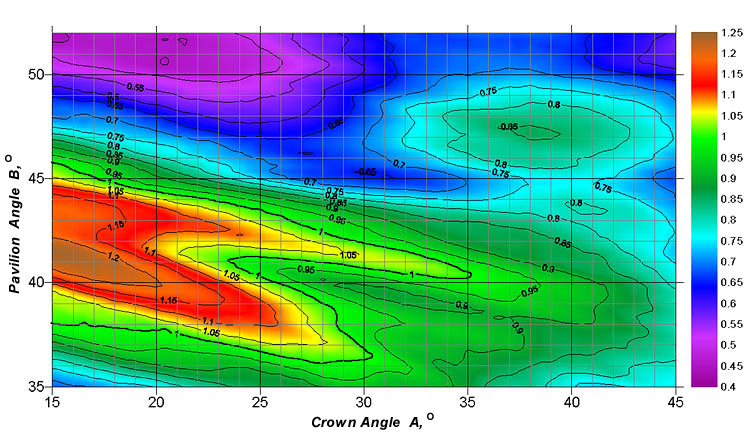
b) Fire
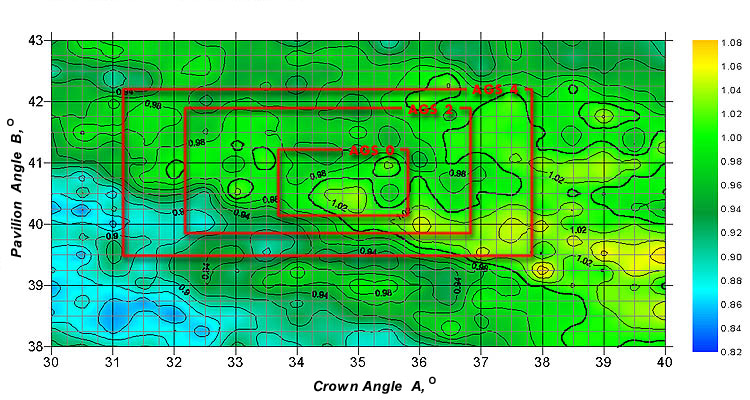
c) Q - Cut quality
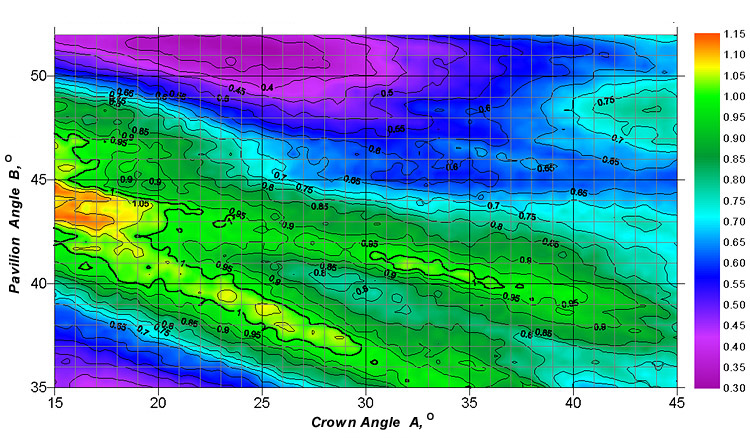
The detailed results of diamond cut studies
These calculations were done using early ray-tracing algorithms; since then we have learned that there are many more complex variables. We found that the variables associated with the viewing conditions in and in particular, the observer, required a new approach to usual 'ray tracing' software.
We will outline some of the main findings in our studies of psycho-physiology. Part of them, as we believe, we have successfully modeled in our software using 3D parametric (perfect) diamond models. This software will predict diamond Basic Light Responses (BLR). These responses correspond with human evaluation of diamond optical appearance.
The chart below outlines most of the effects that need to be understood and considered by the software:
| Three main groups of factors that determine the visual appearance of a diamond |
||
The Source and type of Illumination
|
Optical effects of diamond
|
Viewing conditions
|
The Viewing Conditions
Let us turn our attention to perhaps the most complex of the three sets of variables outlined above; the psycho-physiology of the observer. This important factor is the one least studied in the field of diamond cut studies.
a) Contrast
.gif)

Figure 1. The average brightness is the same for all examples
The eyes adaptation to a background shows us that brilliance is more than simply light return. Spatial contrast is also important. All 6 pictures in fig. 1 have the same light return, but are differentiated in brilliance; the difference in brilliance is perceptual and is a result of differences in contrast.
b) Subjective brightness depends on luminance; a small amount of leakage will have a much smaller effect on subjective brightness because the relationship between perceived brightness and light return is not linear. For example direct light measurement devices that implement various lighting schemes may reveal partial light leakage through a diamonds pavilion facets. Observation of a leakage area might lead the observer to conclude that this area of the diamond will not appear to sparkle, where-as the partial light return area may still be perceived as sparkling. In an example from fig. 2, one particular area in this diamond may have 50% leakage, but the same area has 85% of subjective light return into an eye.

Figure 2. Subjective brightness depends on luminance. Little leakage almost the same as no leakage
c) Primary and secondary light sources. Some areas in a diamond are seen as bright sparkles, while other areas are still white (bright) but are not perceived as a sparkle. The nature of 'sparkle' is dependant on light sources that we could consider to be primary and secondary sources.
If we trace a light ray from an eye through a sparkling area in a diamond, and follow it further to its source, the ray would go directly into source of illumination what we call the "primary" illumination source. Follow a light ray through a white (but not sparkling area) and it may go to a surrounding wall, ceiling, floor or other object that reflects light emitted from a primary light source; that is from a "secondary" light source.
d) The stereoscopic nature of human vision results in the brain receiving two images that it 'superimposes', but our mind does not interpret this function like a simple averaging. The following test illustrates the complexity of how our brains create images. The simple averaging of two pictures (fig. 3) seen by each eye does not result in the same image that is seen with one eye from the face up position. Understanding stereovision is essential for evaluation of diamond beauty. This is a problem in the use of any direct assessment method that uses data or images from a single lens view.

Figure 3. Stereoscopic nature of human vision.
a) Straight Face-up position;
b) Picture for left eye; c) Picture for right eye.
The two pictures fig. 4 below illustrate a property of human stereoscopic adaptation for dark and for light backgrounds.
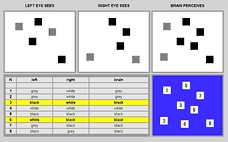
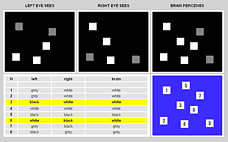
Figure 4. Human stereoscopic adaptation for dark (left) and for light (right) backgrounds.
e) Sparkle, pupil motion and eye reaction.
A special simulation for understanding these phenomena has been constructed in Brill software.
When you play this 'game' you will understand that your mind 'sees' or imagines it sees flashes that are not present. The same happens with diamonds, and it is caused by temporal contrast; it is an important psycho-physiological response to scintillation and is part of the BLR factors that need to be considered by any cut grading system.
From the study of human psycho-physiology we have learned that it is important to evaluate light response of diamond not objectively as a measuring device but subjectively as it is seen by human eye and is perceived by human brain.
Illumination
What should be taken into account in the accurate illumination model?
As a result of these developments it is now possible to develop a system for grading the quality of diamond cut of any individually scanned diamond using 'Basic Light Responses' (BLR) of the diamond in conjunction with formalized criteria established by experts. This means an expert cut quality assessment system is now feasible that could be applied to any diamond irrespective of its shape or symmetry.
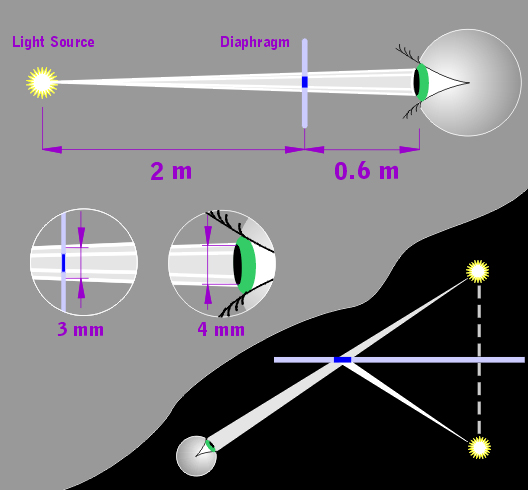
Figure 6. Diamond facet as additional diaphragm for light source
Stage 2. Basic Light Responses. Work with real diamonds
We have shown some of the complexities that we have discovered in our studies. As a result of these and other discoveries not shown, we now believe it is now possible to develop a system for grading the quality of diamond cut of any individually scanned stone using 'Basic Light Responses' (BLR) information in conjunction with formalized criteria established by experts. The idea is discussed in our article in these proceedings titled 'A Strategy for Development'. This expert cut quality assessment system will also be applicable to any diamond irrespective of its shape or symmetry.
The validity of the computer software BLR output will be based on a comparison of data from scanned 3 Dimensional models of the diamonds under consideration using the flow chart below:
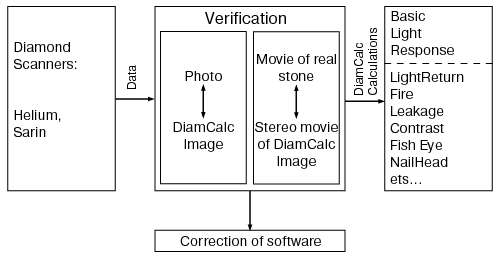
OctoNus tools for these tasks:
HELIUM software for precise 3D model building for polished diamonds and semi-polished diamonds.
- Symmetry evaluation on the base of 3D model
- ReCut option
DiamCalc software for real time photorealistic modeling for real diamonds scanned on Sarin or OctoNus scanners and for parametric diamonds.
- BLR calculations: Light Return, Leakage, Contrast, FishEye for every cut style.
- Ray tracing abilities.
- Parameterization of scanned diamonds. Calculation of optical features with some cut parameters changing.
- Changing of lighting/observing conditions including known structural lighting.
- Movie recording with stereo ability - scintillation study.
- Changing absorption spectra - ability to work with colored diamonds and other gemstone materials.
Stage 3. Master Stones for cut grading. Testing of human observation of diamond appearance
Beginning with a set of Master Stones and following the strategy outlined above, it is possible to define a set of Basic Light Responses (BLR) for human observation of diamonds. It would then be possible with those BLR features to grade any diamond.
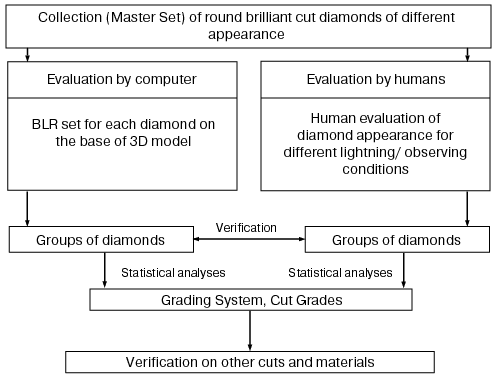 Correlation between two clusters (groups) of diamonds can be established with help of fuzzy logic technology.
Correlation between two clusters (groups) of diamonds can be established with help of fuzzy logic technology.
ETAS
A part form Basic Light Responses that are strongly dependant on illumination conditions we introduce a new type of BLR not dependent on illumination but describing fundamental cut properties - the possibility of a cut diamond to increase the visible part of space.
A diamond is an optical instrument that redirects light from illumination sources and distributes it into surrounding space. A diamond splits a light beam into several smaller (secondary) beams; their effective total angular size (ETAS) may be greater or smaller than that of the primary one.
An increment in number of virtual facets can result in an increase or a decrease of ETAS. While the number of facets is small enough, ETAS grows with the number.
A decrease of ETAS begins when the size of virtual facets becomes so small that blinding reduces the brightness of primary source to the level comparable to that of secondary sources.
It is important to evaluate light response of diamonds as they are perceived by the human mind. Two important effects are that light rays are not simple parallel beams, the simplification used by scientists and most ray tracing software (see fig. 7). Secondly, as we have shown, the eye is not an objective measuring device. But not only does it suffer (or enjoy) perceptual variations, it also has its own geometry of lens and receptors.
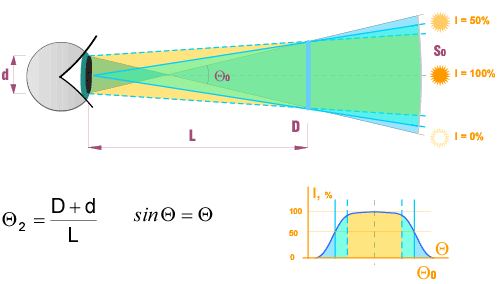
Figure 7. The light source is in focus
Virtual diamond facets
A virtual facet of diamond can be explained by the overlapping the crown and pavilion facets.
A good diamond should have two types of virtual facets: small facets guarantee that at least one sparkle is always visible, and big facets reveal bright sparkles.
The virtual diamond facets modeled in DiamCalc after second internal light reflection (see fig. 8).
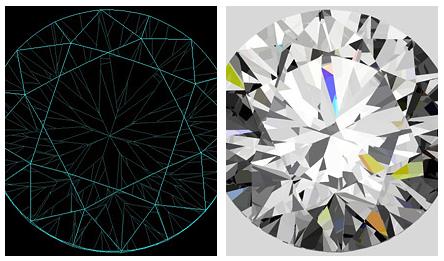
Figure 8. The virtual diamond facets modeled in DiamCalc after
second internal light reflection.
It is apparent that this actual diamond has even more virtual facets than that shown in the wire model; these result from the next level of internal reflections, the third, forth and so on. There comes a point where the virtual facets become too small for us to observe them and this brings us to issues like what size should the virtual facets be for diamonds of different sizes? The size of a diamonds virtual facets can be related to their number and the stones geometry; for instance princess cut appear to have more and smaller virtual facets than a round brilliant which has more facets. Another factor that affects the size and quantity of virtual facets is diamond symmetry. We believe it is possible to improve the appearance of larger diamonds with certain planned asymmetry, where as better symmetry has good validity in smaller sized stones.
Conclusion
The methodology described here, in our opinion, is an optimal way to develop a reliable and useful diamond cut grading system. For the proper modeling of diamond appearance it is important to adequately model not only diamond itself but also lighting and viewing conditions. It is important to move grading from proportions and parametrical approach to the optical appearance of diamond.
Basic Light Responses of diamond can be evaluated from precise 3-dimensional diamond models, and diamond cut grading based on these Basic Light Responses makes it possible to range diamonds by their cut quality. The diamond characteristic ETAS (Effective Total Angular Size) introduced here is a parameter showing the sparkle (scintillate) possibility for each particular diamond.
This methodology applies the same approach to all cuts. It is distinctive from all other approaches because it allows verification of grading systems and grading of fancy cuts and other (non diamond) materials.
We believe that implementation of described methodology to diamond industry will led to creation of more beautiful diamonds and new beautiful cuts. The diamond trade also can benefit from cut grading system with increasing profit selling more beautiful diamonds.
